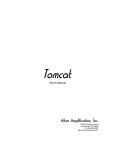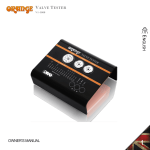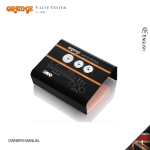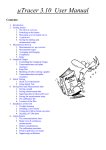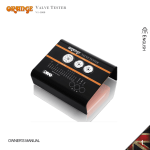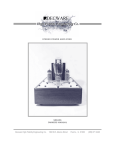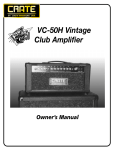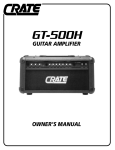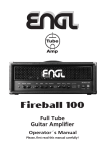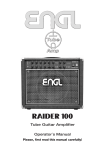Download ENGL Gigmaster 15 Combo E310
Transcript
Gig Master 15
Tube Guitar Amplifier
Operator´s Manual
Please, first read this manual carefully!
The
Gig Master 15 is an amp purpose-designed for performance and voiced with premium tone
in mind. Both the combo and head come in exceedingly compact housings. The Gig Master 15 is
perfect for small gigs, home or studio recording, and practicing at lower volumes without sacrificing
tone. In fact, because it is endowed with hip features such as a balanced Line Out with speaker
simulation and a built-in Power Soak with four variable power stages, this amp is well-suited for a wide
range of diverse applications. Its Master knob lets you dial in precisely the desired amount of power
amp saturation. Two EL84 pentode power tubes produce the amp's trademark tone, while an ECC83
double triode preamp tube provides oodles of front-end overdrive. No one-trick pony, the Gig Master
15 offers plenty of variety for the tone connoisseur courtesy of its two channels and a specially voiced
Mid Boost switch that shapes those midrange frequencies that matter so much to electric guitar tone.
And although these two foot-switchable features afford you even greater flexibility to shape sounds
on the fly, handling remains an exercise in convenience and simplicity. With its warm, bluesy tube tone,
this amp is certainly a strong persuader: Plug in, play, and be convinced!
You'll find guidelines on care and maintenance of tube amps and details for the Power Soak handling
in certain places of this manual.Please read and heed these before operating your amp. You'll also
come across boxes shaded grey throughout the manual. These are located between the descriptions of
the amp's functions and contain handy tips on the preceding function. All critical information
pertaining to the operation of this amp is preceded by "NOTE" or "CAUTION." Please pay particular
attention to these safety tips. The ENGL team wishes you all the best—may you and your amp enjoy a
"harmonically rich" future together!
Front Panel Features
Input Gain Lead Drive
Bass
Middle
Treble
Lead Volume
Master
Gig Master 15
Input
Mid Clean
Boost Lead
Stand By Power
1
2
3
4
5
6
7
8 9
10
11
12
1 Input: ¼" unbalanced input jack. Plug your guitar in here using a shielded cord.
2 Input Gain: This knob controls the preamp's input sensitivity. Use to dial in the desired amount of
gain for the Clean and Lead channels. It and the Master (10) knob determine the Clean channel's
volume. Note: Turning the Input Gain knob all the way down gives the lowest input sensitivity.
A tip from the designer:
If you want to keep the preamp signal pristine clean, dial in a setting between 7 and 11 o'clock for
active and humbucking pickups, and between 9 and 1 o'clock for single-coil pickups. The power
amp provides a moderate amount of headroom, so be sure to choose a relatively low Master knob
setting (lower than 12 o'clock) if you wish to avoid any kind of break-up. Even in Clean mode, you
can push both the amp's preamp and power amp hard enough to overdrive the signal.
3 Lead Drive: This knob controls the Lead channel's sensitivity. It and the Input Gain (2) determine the
amount of preamp distortion in Lead mode.
Note: The amp's noise floor will increase appreciably if you crank both the Lead Drive and
Input Gain knobs!
CAUTION: Extremely high gain and volume levels in Lead mode can produce powerful feedback.
Avoid feedback squeals; they can lead to hearing loss and damage speakers! At higher volumes,
back off the Gain and Treble levels in order to prevent unchecked feedback!
A tip from the designer:
Again, it's the combination of Input Gain (2) and Lead Drive (3) settings that control the amount of
preamp overdrive. You can use these two knobs to set the desired amount of Gain in Clean and Lead
modes, and then dial in the perfect balance between the two. Note that setting the Lead Drive knob
to around 10 o'clock will give you a tougher rhythm tone with a little added edge.
4 Bass: Bottom end voicing control of the preamps´s passive EQ.
5 Middle: Mid-range voicing control of the preamps´s passive EQ.
6 Treble: Upper range voicing control of the preamps´s passive EQ.
Tips from the Designer:
To help you get acquainted with the amp's fundamental sounds, I recommend that you set all tone
controls to the center or 12 o'clock position. If you want to dial in very soft lead, blues, or jazzy clean
sounds, try setting the Treble knob between 11 and 1 o'clock. For more aggressive riffs or
funk-approved tone, try a knob position between 1 and 4 o'clock.
7 Lead Volume: Volume control for the Lead channel (pre-FX loop, influences the Send level).
The red LED above the channel switching selector (9) indicates Lead operating mode.
Use this knob to dial in the desired balance of levels between the Lead and Clean channels.
8 Mid Boost: This voicing feature operates globally, affecting both channels by boosting specific
midrange frequencies when activated. The LED above the button lights up to indicate Mid Boost is
activated. It may also be switched using a footswitch connected to jack 15.
When a footswitch is plugged in, the front panel Mid Boost button is disabled.
A tip from the designer:
Mid Boost targets and shapes specific midrange bands crucial in voicing a guitar's sound.
This tone-shaping option is remotely controllable via footswitch, so you can adapt the amp's
fundamental sound on the fly, say to better support rhythm guitar work, singing leads, and slashing
power chords.
9 Clean/Lead: Channel selector pushbutton for Clean and Lead modes, red LED indicate Lead mode;
This function can also be activated via the respective footswitch connected to jack 15.
Once a footpedal is connected, the channel selector pushbutton is deactivated.
10 Master: Master volume control for power amp output (located post FX loop).
11 Stand By: Power amp standby switch: Use this switch to silence (0 position) the amp when you
take a break. The amp's tubes stay warm, which means that it is ready to roll immediately
when you switch it back to full power. The standby switch is also well-suited for muting the amp
for brief breaks, for instance when you're switching guitars.
A tip from the designer:
I suggest you get into the habit of using standby during short breaks. In this mode, current is not
piped through the power tubes, so they don't get as hot (due to the lack of anode dissipation) and
are spared considerable wear. The amp is ready to run when you flip the Standby switch because
the tubes are already warm and don't require time to heat up. For breaks of 30 minutes and
longer, I recommend that you switch the amp off in order to conserve energy.
12 Power: AC power on/off.
Please note: ensure that the Stand By switch (11) is set to Stand By (0 position) before you switch
the amp on. Let the tubes heat up for about 30 seconds before you activate the power amp. This
procedure spares the tubes.
CAUTION: After an extended period of operation and higher ambient temperatures the amps's
chassis can become very hot, therefore avoid touching the rear panel surface !
Rear Panel Features
R
CAUTION !
Footswitch
FX Loop
Tube
Guitar Amplifier
Gig Master 15
Combo:
Type E310
Head:
Type E315
REPLACE FUSE
ONLY WITH SAME
TYPE AND RATING !
13
14
Clean/Lead
Mid Boost
Send
Return
15
16
17
Amp-Design by
Horst Langer
ENGL Amps
Germany
!
DO NOT OPEN !
RISK OF ELECTRIC SHOCK !
DO NOT EXPOSE THIS
EQUIPMENT TO
RAIN OR MOISTURE !
Balanced
Line Output
Poweramp Output
A
B
Note:
Power Soak
affects
8 Ohms
output only!
Important:
Connect
Frequency
8 Ohms
16 Ohms serial one 16 Ohms
cabinet to
Comp. E310-Combo:
1 x 16 Ohms
output jack A!
internal speaker 2 x 8 Ohms
18
19 20
21
13 Mains Connector (AC Power Inlet; IEC - C14 connector)
Plug the mains cord in here. For European models, use a standard non-heating equipment
connector cable.
CAUTION: Make sure you use an intact mains line cord with a grounded plug! Before you power
the amp up, ensure the voltage value printed alongside the mains socket is the same as the current
of the local power supply or wall outlet.
Please also heed the guidelines set forth in the separately included pamphlet, Instructions for the
Prevention of Fire, Electrical Shock and Injury.
14 Mains Fuse Box: The rear chamber contains the mains fuse and in the front chamber, a spare fuse.
CAUTION: ALWAYS make sure replacement fuses are of the same type and have the same ratings
as the original fuse! Please refer to the fuse ratings table.
15 Footswitch Clean/Lead; Mid Boost: Use this ¼” Stereo jack to connect a conventional footswitch
with two switching functions, for example, the ENGL Z-4 (2 x off/on - Single Pole Single Throw or
SPST for short). This type of footswitch lets you access the two channels and Mid Boost.
One of the two switches activates Clean or Lead, while the other activates Mid Boost.
Plugging a footswitch into this jack disables onboard channel (9) and Mid Boost (8) switching.
Note also: A footswitch may be equipped with LEDs indicating the given switching status.
Each of the two switches is provided with approx. 10 milliamperes current, which suffices to power
a standard LED. The jack's mono terminal ("tip") selects Clean / Lead switching, while the stereo
terminal ("ring") controls the Mid Boost, feature.
For pin assignments, see "Wiring of Principal Connectors".
A Tip from the Designer:
If you want to control the amplifier via a MIDI system, use jacks 15 and a Looper or MIDI Switcher
(e.g. ENGL Z-11). Use two stereo ¼" cords to connect the ENGL MIDI Switcher Z-11 (optional). You
can then preset the two switching functions Clean/Lead and Mid Boost via the Switcher, store your
custom switching setups as different MIDI programs and activate the presets via a MIDI board
(e.g. ENGL Z-12).
16 FX Loop Send: Connect the FX Loop output to a signal processor's input/return jack using the
shortest possible shielded cord equipped with ¼” plugs.
17 FX Loop Return: Connect the FX Loop input to a signal processor's output/send jack using the
shortest possible shielded cord equipped with ¼” plugs.
Note: The FX Loop is sited between the preamp and power amp. Inserting a ¼” plug into the
Return jack interrupts the signal path between the preamp and power amp.
18 Balanced Line Out Frequency Compensated: The frequency-corrected, balanced Line output jack
(¼ stereo jack: tip and ring routes the balanced signal, shaft = Ground/Shield). This signal can be
routed directly to a mixing console or a recording unit. The line out is located post poweramp in
the signal chain, so ensure the poweramp is activated.
If you wish to run the amp without driving a speaker, the built-in Power Soak (22) can provide
the necessary load for the power amp. To do this, simply set its Selector to "Speaker Off."
In this mode, you can run the amp without a speaker or cabinet connected, for example,
to the E315 Head's speaker outs. Never use the Power Soak with speakers connected
to the 16-ohm outputs (jacks 20 and 21)!
Heads up: Make sure the balanced cord's shielding is grounded at one end only; that is, either at
the amp or at the mixer or recorder. Connecting two devices to the same ground (e. g. via the
mains ground) can cause a ground loop that you will recognize as audible humming!
You may find it necessary to sever the connection between the shielding and ground on one of the
stereo ¼” cord's two plugs.
A Tip from the Designer:
The Line Out’s output level is influenced by the following factors: By the input level (Gain), the
Volume control settings in the Lead channel, to some degree by voicing control settings, and by
the Master volume level. First dial in the desired sound combination at the front panel. Then adjust
levels at FX devices or signal processors (if connected).
Use the respective device’s input sensitivity or gain control for level adjustments.
You can also tap the line out signal at this jack using an unbalanced cord with a mono plug;
that is, with one wire carrying the signal and the shielding providing the grounding.
An internal resistor protects the second output against short-circuits.
19 Poweramp Output 8 Ohms: 8 ohms speaker output jack. Connect an 8-ohm cabinet or,
in the case of the Combo E310, its internal speaker here.
The Power Soak circuit sits between this speaker output and the power amp. You'll find some
important info on this circuit in section 22, please read carefully before operating the Power Soak!
CAUTION: The built-in Power Soak (22) may only be used in combination with an 8-ohm speaker
(or the E310 Combo's built-in loudspeaker) connected to jack 19!
20 Poweramp Output A -16 Ohms serial: 16-ohm speaker out, connected internally in series with
Output B (jack 21). Connect a 16-ohm cabinet here (Output A). Two 8-ohm speakers are connected
to Output A (jack 20) and Output B (jack 21), for example a combination of the internal 8-ohm
speaker of the Combo E310 and an external 8-ohm cabinet, e.g. the ENGL models E112 or E412.
CAUTION: If you intend to use a 16-ohm cabinet only, make absolutely certain you connect it to
Output A (jack 20).
Output B (jack 21) is only enabled when a speaker is connected to Output A (jack 20).
The built-in Power Soak (22) does not work with the two 16-ohm speaker outs!
Never activate the Power Soak when a speaker is connected to output A (20) or speakers
are connected to the outputs A and B (jacks 20 and 21)!
Power Soak deactivated (switched off): see chapter 22 for more information.
21 Poweramp Output B - 16 Ohms serial: This is an auxiliary output connected in series with Output A
(jack 20). This output is designed for one application for only—when you are driving a combination
of two 8-ohm cabinets/speakers. This output may only be used when an 8-ohm speaker is
connected to Output A (jack 20). (See the example in chapter 20)
NOTE: Never operate the amplifier without a sufficient load, otherwise you may damage or
destroy the power amp!
When set to "Speaker Off," the Power Soak provides an adequate load for the power amp.
Speaker/ cabinet options:
You can connect one 8-ohm cabinet to the 8-Ohm Output (19) in combination with the Power
Soak circuit and select any setting, or connect one 16-ohm cab to Output A (20) or two 8-ohm cabs
to Output A and B (20 and 21) without the internal Power Soak. Selecting the "Full Power" setting
deactivates the Power Soak!
Power Soak Panel
R
I. Full Power
II. 5 watts
III. 1 watt
IV. Speaker Off
POWER SOAK
Power
Range
Selector
22
Full Power
Power
Range
Selector
Full Power
Power
Range
Selector
Full Power
Power
Range
Selector
Full Power
5 watts
5 watts
5 watts
5 watts
1 watt
1 watt
1 watt
1 watt
Speaker off
Important note:
the Power Soak only
affects the 8 Ohms
Poweramp Output!
Speaker off
Power Soak
not active
Speaker off
Power Soak
activated
Speaker off
Power Soak
activated
Power
Range
Selector
Full Power
5 watts
1 watt
Speaker off
Power Soak
activated
22 Power Range Selector: Use this switch to activate the Power Soak and select the desired power
level. The Power Soak works only in combination with the amp's 8-Ohm Output (19)!
You have four options:
The first setting (I) is "Full Power." It deactivates the Power Soak and feeds the power amp's full
output to the 8-Ohm (19) or 16-Ohm (20) speaker outputs.
The second setting (II) is "5 Watts." It activates the Power Soak and reduces the power sent
to the 8-ohm cabinet connected to the 8-Ohm Output (19) to 30 percent (about 5 watts).
The third setting (III) is "1 Watt." It activates the Power Soak and reduces the power sent
to the 8-ohm cabinet connected to the 8-Ohm Output (19) to 5 percent (about 1 watt).
The fourth setting (IV) is "Speaker Off." It activates the Power Soak, whose resistors convert the
power amp's full output to heat, and switches the cabinet connected to the 8-Ohm Output off.
CAUTION: The Power Soak circuit works only in conjunction with an 8-ohm cabinet connected to
the 8-Ohm Output (19). Make absolutely certain a speaker is connected to the 8-Ohm Output - for
example, the E310 Combo's internal loudspeaker or an 8-ohm cabinet to the E315 Head - before
you engage the Power Soak by setting switch 22 to "5 Watts" or "1 Watt." The opposite goes for
the two 16-Ohm A and B outputs (jacks 20 and 21): Never activate the Power Soak by setting it to
"5 Watts", "1 Watt" or "Speaker Off" when cabinets are connected to the 16-Ohm outs! Be sure to
first disconnect any speakers plugged into these ports. If you select "Speaker Off," you can run the
amp (in most cases, the head) without a connected speaker.
If you want to drive one 16-ohm cabinet connected to the 16-Ohm Output A (jack 20) or two
8-ohm cabinets connected in series to outputs A and B (jacks 20 and 21), be sure to set the Power
Range selector (22) to "Full Power"! And if you connect an external 16-ohm cabinet to the E310
Combo, be sure to disconnect the built-in speaker before you power the amp up!
Heads up: When activated, the Power Soak's resistors convert some or all of the power amp's
output into heat. These heavy-duty resistors reside on a circuit board behind a steel grille.
Ventilation is important for every tube amp, but all the more so for this amp because the
temperature around the Power Soak circuitry can climb quite steeply depending on the Master
volume and Power Range Selector settings. So, make sure air can circulate freely around the back
of the amp!
Do not operate the amp at peak loads – that is, with the Master knob set to 12 o'clock or beyond,
pushing the power amp hard into overdrive - for longer periods with the Power Soak activated
because its power resistors may overheat!
Important tips from the designer:
You can use the Power Soak, which attenuates the signal sent to the onboard 8-ohm speaker or an
outboard 8-ohm cabinet, for several purposes. For example, you may want to shape your tone with
moderate (!) power amp saturation, but the volume with the Master knob cranked may be too
loud for the situation or location. In that case, simply cut the power sent to the speaker. You can
opt to reduce output by two-thirds or even down to just one watt. The "1 Watt" setting drastically
reduces the volume level, though it will still be loud enough for monitoring during recording
sessions. The Power Soak Selector's "Speaker Off" is the setting of choice when you want to mute
the speaker for direct-to-desk recording. The power amp's entire output is then fed to the Power
Soak's heavy-duty resistors, which ensure the power amp gets the load (8 ohms) it needs to run
safely. If you are using the Power Soak in combination with the Clean channel, don't drive the
power amp too hard by setting the Master to 12 o'clock or beyond because its tone will suffer and
the power resistors' temperature will rise sharply.
If you do set the Master to 12 o'clock or beyond, I highly recommend that you back off the Bass
and Input Gain knob settings, particularly for the Clean channel, to prevent undesirable clipping.
Bear in mind the golden rule that no speaker or cabinet may be connected to the 16-Ohm Output
(jack 20) when the "Speaker Off" setting is engaged. When in doubt, always check first!
If you want to record via the Line Out without a connected speaker – typically a cabinet connected
to the head – simply select "Speaker Off". The Power Soak's heavy-duty resistors will provide the
necessary load for the power amp.
Technical Data
Rated power:
Input sensitivity level Input, Clean channel:
Input sensitivity FX Return:
Output level FX Send, level range:
Tubes:
V1:
V2, V3:
Fuses:
external:
internal:
(internal fuse located at the power transformer)
Power Tube Fuses (internal on main PCB):
Important:
Power Consumption:
Dimensions:
Head - E315
(W x H x D)
Combo - E310
Weight:
Head - E315
Combo - E310
approx. 15 watts at 8 or 16 ohms;
-20 dB
-10 dB, approx. +10 dB max.;
-10 dB to approx. +7 dB peak;
ECC 83 (12AX7) selected;
EL 84 (6BQ5) matched set.
0.315 ATL (slow) for the 230 Volt model;
0.63 ATL (slow) in the 100 and 120 Volt models.
0.5 ATL (slow) for the 230 Volt model;
1 ATL (slow) in the 100 and 120 Volt models.
2 x 0.063 AM (medium blow)
Replace fuses only against same type and rating!
approx. 70 watts max.
approx. 42 x 20 (22) x 23 cm; 16.5" x 7.9" x 9";
approx. 42 x 38 (40) x 23 cm; 16.5" x 14.9" x 9";
approx. 8.4 kg; 18.5 lbs;
approx. 13.4 kg; 29.5 lbs;
Tube array:
Power Soak
connector
V1
ECC83
Output
Transformer
V2
V3
EL84 EL84
Input
Head
E315
chassis
viewed
from
above
Power
Transformer
Power
Transformer
Combo
E310
chassis
viewed
from
above
Output
Transformer
V3
V2
EL84 EL84
Power Soak
connector
V1
ECC83
Input
Handling and Care
* Keep the amp safe from hard knocks and shocks. Tubes are fragile and tend
to suffer when exposed to mechanical stress!
* Let the amp cool down before you transport it. Ten minutes or so will spare the tubes.
* Tubes take some 20 seconds to warm up after you switch the power on, and
about two to three minutes before they are able to pump out full power. Make a habit of giving
your amp plenty of time to get toasty and flipping the Standby switch for short breaks.
* In order to spare the power tubes and prolong their lifetime, we recommend to set the
Stand By switch to Stand By (0 position, that is) before you switch the amp on. After a period
of 30 seconds you may activate the poweramp by flipping the Stand By switch.
* Avoid storing the amp in damp or dusty rooms to spare jacks, switches and potentiometers.
If you don't use the amp all the time, I recommend that you drape a covering over it to prevent
the intrusion of dust. Even better, keep it in a transport cover or flight case.
* Never use caustic or scouring detergents to clean the amp's housing, front or rear panels.
Use a soft, damp cloth or sponge with diluted soapsuds or a standard brand of mild dishwashing
liquid instead. Never use solvents they can corrode the amp's vinyl skin and dissolve the front and
rear panel labels. Keep liquids well away from the amp, particularly the interior of the housing.
* Make sure air can circulate at the rear and top of the amp to allow for adequate cooling,
which increases component life.
* Never operate the amp without an adequate load (a speaker, cabinet or suitable terminating
resistor, i.e. the internal Power Soak circuit).
* High ambient temperatures place an additional strain on diverse components; so if at all possible,
avoid operating the amp at temperatures far higher than 30°C (86°F) for longer periods.
Running the amp at mains voltages exceeding the nominal mains input voltage over longer periods
can also shorten component life.
* Replace tubes with selected tubes that satisfy ENGL selection criteria to forestall microphonic
properties, undesirable noise and unbalanced power amp signals.
Because power tubes' idle current (bias) must checked and possibly adjusted when replacing tubes,
this is a job best left to experienced and authorized specialists.
Troubleshooting
* The amp does not power-up after you have switched the power on.
The control lamp inside the power switch (12) does not light.
-> Is the mains cord connected to the receptacle / live power source ?
-> Is the power cable you are using intact ? Try another equal mains cable.
-> Is the mains lead properly connected to the AC Power Inlet (13) at the amp ?
-> Possibly the mains fuse (14) has blown, unplug the mains cord from the mains connector
and the receptacle and check the mains fuse.
* The amp does not power-up after you have switched the power on. The control lamp inside the
power switch (12) lights up but the Channel & Mid Boost switching functions do not react,
i.e. the corresponding control LED's do not indicate an active function;
moreover no sound is emanating from the connected speaker.
-> Possibly the internal mains fuse has blown. Let this fuse check by a professional technician.
* The amp fails to respond when you try to control switching functions remotely
using a footboard such as the Z-4 or a MIDI switcher such as the ENGL Z-11.
-> Is the footboard (or the switching loops) connected to the corresponding footswitch jack (15) ?
-> Are the cords you are using stereo, intact, and wired properly ?
(Refer to "Wiring of Principal Connectors" for pin assignments.)
-> If you are using footswitches other than an ENGL Z-4 or Z-11, are the switches or relays inside the
boards or switching loop systems off / on Single Pole Single Throw (SPST) switches? In other words,
do these switches continuously connect to GND when you wish to activate the given function?
If you're unsure about the answers to these questions, consult an authorized service center or a
professional specialist.
* The amp is not providing an output signal / no sound is emanating
from the speaker.
-> Is at least one speaker connected to the speaker outputs 8 ohms (19) or 16 ohms (20) ?
-> Is the power amp activated (Standby switch to ON) ?
-> Are all cords (guitar, effect, and speaker) connected properly and are they functional ?
-> Unplug connected effectors and see if the preamp works fine without these peripheral devices.
-> Is the Power Soak Selector (step switch; 22) set to “Speaker Off? “
In this case, the 8-Ohm Output (19) is switched off!
Set the Power Soak Selector (22) to another position, e.g. "Full Power."
-> Are the Master, Gain or Volume knobs set to a value greater than 0 ?
If any of these knobs is fully down, no signal is routed to the amp's outputs.
-> You may be looking at a faulty tube or another defect. (the internal power tube fuses blown, etc.)
In this case, be sure to take the preamp to an authorized, professional service center.
* The speaker is emitting humming noises:
-> Is there a connection (for example, via a shielded circuit, e.g. Line Out) between the amp
and another device that is grounded via a power plug of its own?
Two or more circuits sharing a common electrical ground line can cause audible hum.
If low-frequency noise is emanating from your rig, be sure to consult a specialist.
-> The amp and mains grounds are not connected properly or are altogether
disconnected. Have an experienced specialist check this.
-> Cords connected to the input or effect loops may not be shielded properly.
Replace them to check if this is indeed the case.
-> The amp or speaker cords may be picking up interference from powerful
magnetic fields (for example, of nearby power transformers or electrical motors).
Reposition the amp and connector cables.
-> The amp or speaker cords may be picking up radio signals, for example,
from activated mobile telephones or powerful local transmitting stations nearby.
Switch off mobile phones while troubleshooting noise problems.
CAUTION! Please read and heed the following:
You'll find an ancillary pamphlet accompanying this owner's manual entitled
Instructions for the Prevention of Fire, Electrical Shock and Injury.
Be sure to read it before you plug in and power up the amp!
The different options for controlling the Gig Master 15 amp remotely
R
CAUTION !
Footswitch
FX Loop
Tube
Guitar Amplifier
Gig Master 15
Combo:
Type E310
Head:
Type E315
Clean/Lead
Mid Boost
REPLACE FUSE
ONLY WITH SAME
TYPE AND RATING !
Send
Amp-Design by
Horst Langer
Return
ENGL Amps
Germany
!
DO NOT OPEN !
RISK OF ELECTRIC SHOCK !
DO NOT EXPOSE THIS
EQUIPMENT TO
RAIN OR MOISTURE !
Balanced
Line Output
Poweramp Output
A
B
Note:
Power Soak
affects
8 Ohms
output only!
Important:
Connect
Frequency
8 Ohms
16 Ohms serial one 16 Ohms
cabinet to
Comp. E310-Combo:
1 x 16 Ohms
output jack A!
internal speaker 2 x 8 Ohms
Speaker / cabinet options:
*
1.
or
2.
or
16
or
8
MIDI SWITCHER
ifier
Tube Ampl
WRITE
ON/OFF
8
MIDI
CHANNEL
SWITCH
LOOP 1
SWITCH
LOOP 2
SWITCH
LOOP 3
SWITCH
LOOP 4
SWITCH
LOOP 5
SWITCH
LOOP 6
8
ON/OFF
1. Two-way footswitch (e.g. ENGL Z-4): Connect it to the amp via a stereo ¼" cord. You can switch
channels and Mid Boost via the Two-way footswitch connected to jack 15.
2. MIDI-Switcher (e.g. ENGL Z-11): Connect the unit to the amp via a stereo ¼" cord.
The buttons on the Switcher controls Clean/Lead and Mid Boost.
If you program the diverse switching configurations to different MIDI program locations
(e.g. MIDI Preset #1: Clean channel & Mid Boost passive;
MIDI Preset #2: Lead channel & Mid Boost active, etc.)
you can activate the desired configuration directly via a MIDI board (e.g. ENGL Z-9, Z-12
or Z-15). This type of control option is extremely versatile, we recommend it highly if you intend
to use the amp in conjunction with a MIDI system (e.g. MIDI effects devices).
Speaker / cabinet options: * Another option would be to connect two 16-ohm cabinets in parallel
instead of one 8-ohm cabinet.
Wiring of Principal Connectors: Footswitch (15), Balanced Line Out (18)
Stereo
1/4" jack
ring: refer to *2
Use a stereo
plug only!
tip *3
ring *2
sleeve
tip: refer to *3
sleeve: Ground (Shield)
Footswitch jack (15):
*2: A switch connected to this terminal controls
Mid Boost - passive <--> active;
*3: A switch connected to this terminal controls
Channel switching - Clean <--> Lead;
Stereo
1/4" plug
Balanced Line Out jack (18):
*2: the ring carries an
- inverted ("cold") signal;
*3: the tip carries
+ the ("hot") signal with normal polarity;
ENGL Gerätebau GmbH
Internet: www.engl-amps.com
Text, design, graphics, photo and layout by
Horst Langer, ENGL Amp Designer
Technical specifications are subject to change without notice .








